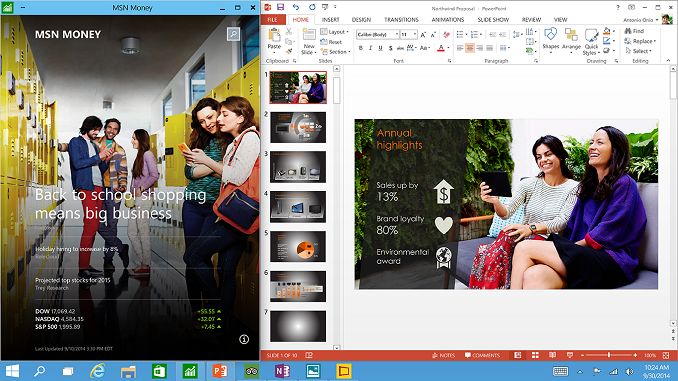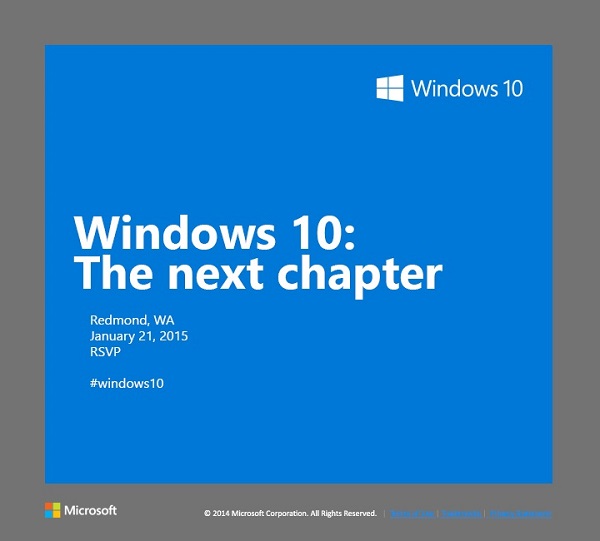Windows 10: The Next Chapter
by Brett Howse on December 11, 2014 6:00 PM EST- Posted in
- Software
- Operating Systems
- Microsoft
- Windows 10

Today Microsoft revealed that they will be hosting an event at Redmond to announce the next chapter of Windows 10 on January 21st, 2015. This event should reveal the Consumer Preview for Windows 10, and build on the changes already shown in the Technical Preview. The Technical Preview was very desktop focused, and did not include the announced features to enable a touch experience. Most likely the consumer preview of Windows 10 will include this, as well as other new features to continue to hone the user experience.
The event will be livestreamed and the Blogging Windows site will offer up information on the announced features. When Microsoft first announced Windows 10, they said that they would be having a consumer event upcoming in the early 2015, and more developer information at Build, so it’s good to see that this is on schedule still. It does appear that the final release for Windows 10 may be Fall 2015 according to Microsoft COO Kevin Turner.
Microsoft also sent out some news to the Windows Insiders letting them know about a few things that may be interesting. First, they have created an Insider Hub app for Windows 10 which is included in the latest build. The app will provide news and announcements regarding the Insider Program and some news may only be shared this way. It will also be a way to help with feedback on new features. People running the Windows 10 Technical Preview can simply pin this hub to their Start Menu to get access to the notifications.
They have also announced that a four hour webcast “Windows 10 Technical Preview Fundamentals for IT Pros” is now available through the Microsoft Virtual Academy, so if you are thinking about possible Windows 10 deployments in the not too distant future, you can check it out here.
Finally, as part of the Internet of Things movement, Windows 10 will support devices with AllJoyn capability. As described by Microsoft Open Tech, “AllJoyn is an open source software framework and set of services to enable interoperability among connected devices to create dynamic proximal networks” and developers who wish to develop apps with AllJoyn capability for Windows 10 can download the SDK from the AllSeen Alliance.
Quite a few changes and additions to Windows came with the Windows 10 Technical Preview, and you can read my initial thoughts here. What the build really is missing though are the consumer focused points. A lot of the initial talk was about deployment, user management, and data security. Quite a bit of the support for WinRT apps and touch was affected, and will likely make their way back in along with the Continuum capability to switch between keyboard/mouse and touch control.
Source: Blogging Windows











39 Comments
View All Comments
hughlle - Thursday, December 11, 2014 - link
define "enable a touch experience"..I'm using 10 predominantly with touch quite happily, it's not that much different to 8.1. Anything but unusable.
Brett Howse - Thursday, December 11, 2014 - link
Continuum is not enabled or available, and switching to the touch first Windows 8.1 style start screen is not as simple as it will be in future versions.Also, the WinRT apps seem to be fairly buggy in the Technical Preview.
hughlle - Thursday, December 11, 2014 - link
Just after your definition of "touch experience". As i said, i use touch on the surface pro 3 and it works just great. It may have bugs as to be expected, but it still works just great. Not sure what much continuum can add. I hit a text field, keyboard pops up, this that and the other. I'm actually finding it a far better touch experience than 8.1 on the whole.In short, sure there might be improvements to be made, but your choice of words seems poor. There is already a touch experience, and a good one at that. You can't enable something that already works.
Brett Howse - Thursday, December 11, 2014 - link
You could also alter your definition. The entire touch UI is not enabled in the current build. Yes, touch still works, but there isn't even a touch browser right now (without hacks).Touch works but the Touch UI is hidden and difficult to get in to. This will change with Continuum. I'm glad you've had a good experience with touch so far, and hopefully with the new build it will get even better.
hughlle - Thursday, December 11, 2014 - link
I couldn't care less about the touch UI. The longer it stays hidden the better imo. Touch works just great as it is. I can use touch quite happily as is, so as such, i have a touch experience.. something you have claimed is not enabled.Naphistim - Friday, December 12, 2014 - link
To quote (and agree with) Brett Howse: "Continuum is not enabled or available".So NO, the experience that Microsoft is planning for the average end-user is not enabled. I do understand what you mean by saying you have a working touch *environment*, but the article is by no means misleading or improperly worded: Continuum is Microsoft's new touch-to-tactile transition experience, and it's not in the Technical Preview. Factual.
Workable environment != UX.
Laststop311 - Saturday, December 13, 2014 - link
continuum is a game changer. Allows all the touch enhancements without hindering normal desktop users. This is how things should be done.powerarmour - Thursday, December 11, 2014 - link
Just as long as a touch experience stays the hell away from my KB&M interface I'll be happytuxRoller - Thursday, December 11, 2014 - link
I hope alljoyn gets some traction. Qualcomm signed the coffee over to the Linux foundation some time ago, so Microsoft making use of it suggests that we might, finally, see a good, ubiquitous, functional standard for networked services and devices.Hairs_ - Thursday, December 11, 2014 - link
1. Focus stealing. If Windows still allows applications to steal focus while you're typing then I'm not jumping.2. Explorer learning what a hard link is. No, Microsoft, users understand perfectly well that WinSxS isn't "really" using all that disk space. Your creepy file explorer still doesn't, and that means we can't use it.
3. Aero theme and texture. This Modern style is fine for smartphones, it's ugly on a decent sized screen. It looks like Windows 3, and that's definitely not modern, hip or groovy.